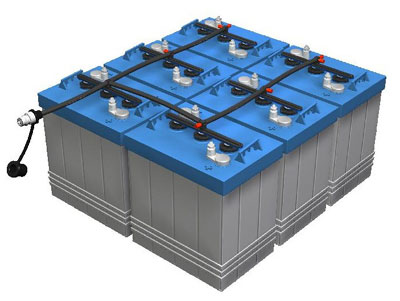
Leading Edge has a wide range of 12V DC solar panels suitable for 12V, 24V and 48V battery banks. Choose from professional-grade monocrystalline glass modules with ultra-high efficiency SunPower cells for a range of industrial/commercial applications, walkable marine solar panels from Solara and flexible solar panels for sailing boats, motor homes and caravans.
By including a wind turbine, you can generate even more power round the clock, not just when the sun shines. Take a look at our range of off-grid wind turbines, designed and manufactured in the UK - contact us for advice from one of our off-grid specialists on choosing one that will suit your power requirements.
Solar or wind energy needs to be stored somewhere and typically this is done using deep-cycle batteries - Flooded, AGM or GEL. For many installations of one or two solar panels, one large battery has enough storage capacity, but for larger systems it may be necessary to connect multiple batteries to create a 'battery bank'.
To work out how much battery storage capacity you need, first you need to know how much power your system will be drawing every day and then follow the simple calculations below. A general rule for all batteries is that the less they are discharged, the longer their service life.
Please be aware that when using an inverter, it should be connected directly to the battery bank and the battery bank must be of sufficient size to be able to cope with the potentially high current draw of the inverter. Theoretically, a current of 1A on the AC side of the inverter can become 20A on the DC side (A = V x W).
|
Inverter Size
|
Typical Battery Bank Size (12V)
|
|---|---|
| 1000W |
420Ah
|
| 1500W |
540Ah
|
| 2000W |
750Ah
|
| 2500W |
1000Ah
|
STEP 1:
Calculate your daily power consumption in Watt-hours (Wh) by adding together the power consumption of each electrical device that you will use. You can calculate the daily power consumption by multiplying the wattage rating of the device by the number of hours it will be used for. If the device does not declare the power consumption in Watts, multiply the current in Amps (A) by the operating voltage (V).
e.g. 4 x 100W lights used for 5-hours a day = 2000Wh/day
STEP 2:
Ideally, a battery bank should be able to supply you with power, even if there is a problem with the solar panels or charge controller. You should now decide how many days' of backup power you would like and multiply the power consumption figure from step one by the number of backup days.
e.g. 2-days' backup : 2000 x 2 = 4000 Wh
STEP 3:
As mentioned previously, regardless of battery type and cost, the longest service life will be achieved by discharging them as little as possible.
Decide on a calculated 'maximum depth of discharge' (DoD) whereby the lower the better and divide the result from Step 2 by this (decimalised).
e.g. 50% DoD: 4000 / 0.5 = 8000 Wh
STEP 4:
All batteries are less efficient at lower temperatures and we can compensate for this in our calculation. Choose the factor that corresponds to the lowest average temperature your batteries will have to work in. Multiply result from Step 3 by this number.
|
Temp. °F
|
Temp. °C
|
Factor
|
|---|---|---|
|
80
|
26.7
|
1.00
|
|
70
|
21.1
|
1.04
|
|
60
|
15.6
|
1.11
|
|
50
|
10.0
|
1.19
|
|
40
|
4.4
|
1.30
|
|
30
|
-1.1
|
1.40
|
|
20
|
-6.7
|
1.59
|
e.g. 21oC = 1.04 x 8000 = 8320Wh
STEP 5:
Depending on the voltage of your electrical system, you may need to connect batteries together to create a bank at 12, 24 or 48V. Using a higher voltage is also a useful way of reducing voltage loss over longer distances or reducing the size of charge controller you need. In order to work out the minimum capacity of your battery or battery bank, divide the result from Step 4 by the desired voltage.
e.g. 8320 / 24 = 347Ah
STEP 6:
Finally, identify how many batteries you need. Ideally, we try to stay within 5% of the calculated size required, so based on the bank voltage and the target Ah capacity.
e.g. 110Ah (12V) deep-cycle batteries for a 330Ah 24V battery bank:
24V = 330 / 110 * 2 = 6 batteries
If you wanted to create a 330Ah battery bank at 12V or 48V, you would need 3 and 12 batteries respectively:
12V = 330 / 110 = 3 batteries
48V = 330 / 110 * 4 = 12 batteries
Tell us about your project
Our Off-grid experts will come back with recommendations




